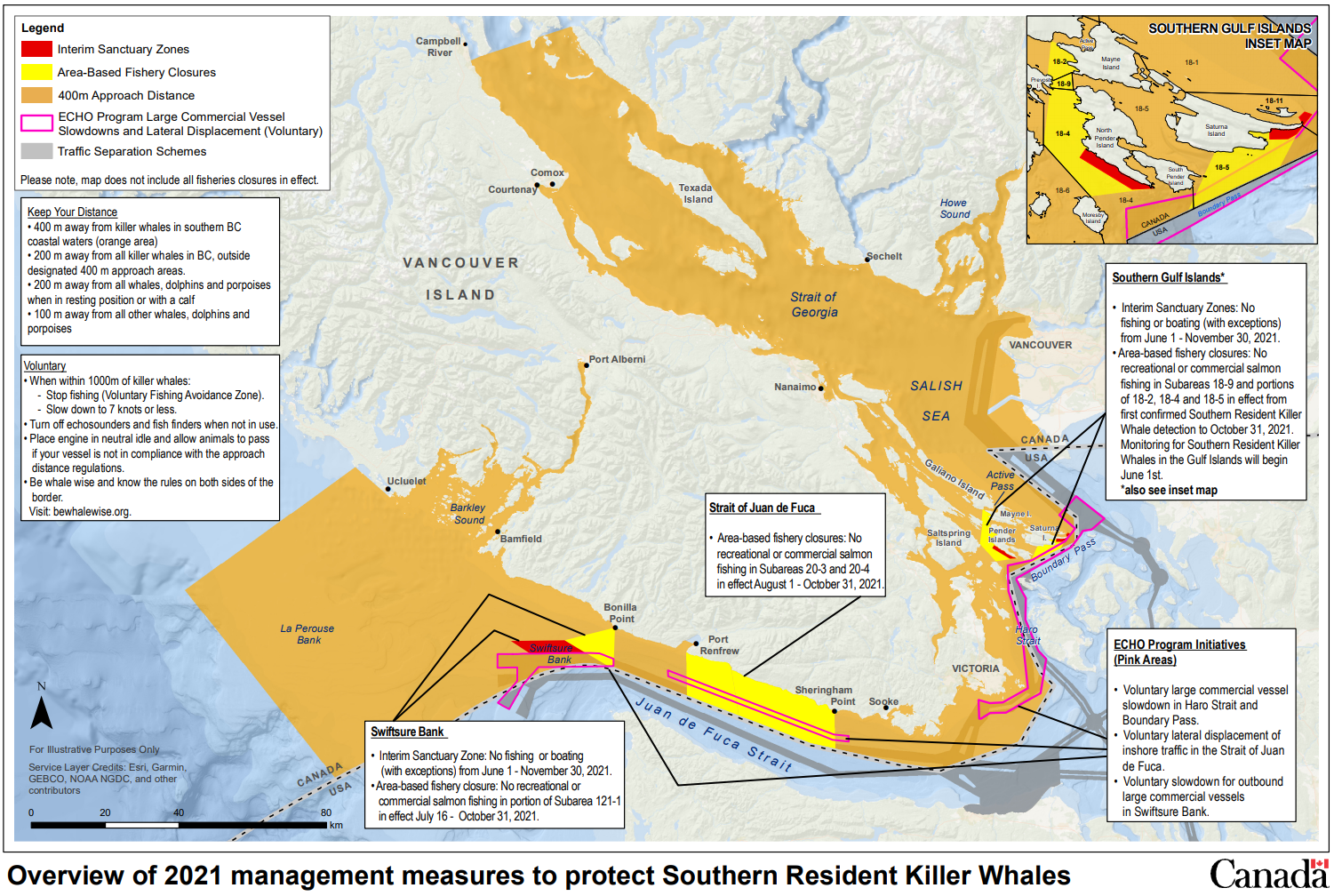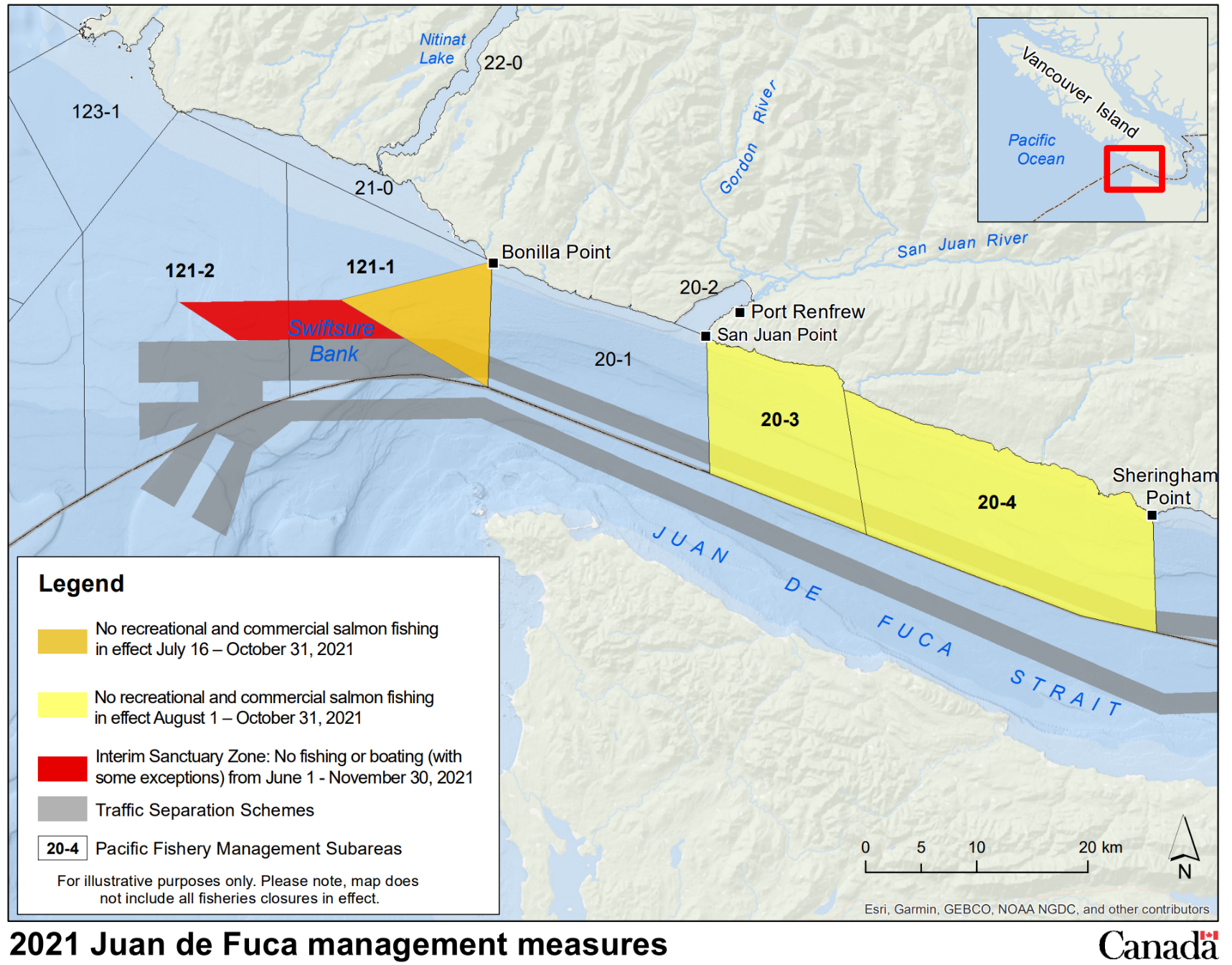RDIMS No .: 17657339
Date (Y-M-D) : 2021-07-28
This bulletin has been replaced by Ship Safety Bulletin No. 15/2022
This bulletin replaces Ship Safety Bulletin No. 19/2020
Purpose
This bulletin is to clarify vessel requirements under the Interim Order for the Protection of the Killer Whale (Orcinus orca) in the Waters of Southern British Columbia, 2021, which came into force June 01, 2021. The Interim Order applies to all vessels that are navigating in, on or through specific waters in Southern British Columbia, regardless of the method of propulsion.
The Government of Canada has put these measures in place to reduce the acoustic and physical disturbance of vessels on the endangered Southern Resident killer whale (SRKW).
Background
SRKW are endangered under the Species at Risk Act, and are vulnerable to the activities of marine vessels. Vessels navigating on or through specific waters in Southern British Columbia, some of which are key foraging sites for SRKW, present risks to South Resident killer whales through underwater noise and physical disturbance, which can impact the ability for killer whales to perform critical life processes such as foraging and communication.
Recognizing the imminent threats to the survival and recovery of SRKW, and the increased threat that vessels can bring in the waters of Southern British Columbia, the Minister of Transport issued the Interim Order for the Protection of the Killer Whale (Orcinus orca) in the Waters of Southern British Columbia, 2021. The measures listed within this Interim Order were developed to mitigate impacts of vessel noise and other disturbances, and to help create a temporary refuge for killer whales. See Figure 1 for details.
These protection measures for killer whales are described in the 2021 annual edition of the Notices to Mariners (NOTMARs), which are published by the Canadian Coast Guard (CCG). These measures are broadcast through Navigational Warnings (NAVWARNs), which are published by the Canadian Coast Guard’s (CCG) Marine Communications and Traffic Services (MCTS) Centres.
What you need to know
The measures listed within this Interim Order are a 400m approach distance restriction and the establishment of interim sanctuary zones. The measures are described below in detail.
400 metre approach distance
These prohibitions came into effect on June 1, 2021 and will be implemented until May 31, 2022.
As per the Interim Order, persons operating vessels or vessels are prohibited from approaching all killer whales within 400 metres of:
- in the Salish Sea south of Campbell River (Figure 1); and
- in the waters that have been identified as their critical habitat (Figure 1).
These restrictions increase the already existing 200 metre minimum approach distance from SRKW, currently in place under the Marine Mammal Regulations, to a 400 metre minimum approach distance.
Interim Sanctuary Zones
These prohibitions came into effect on June 1, 2021 and will be in place until November 30, 2021.
As per the Interim Order, persons operating vessels or vessels are prohibited from navigating in three interim sanctuary zones (Figure 2), which comprise of waters:
- off the southwest coast of North Pender Island (Figure 2)
- off the eastern tip of Saturna Island, (Figure 2) and
- at Swiftsure Bank (Figure 3)
A 20 metre transit corridor alongside the Pender and Saturna Island zones will be available to human powered vessels navigating through these areas. See Figure 2 and Figure 3 for more information.
Exemptions
The following vessels and/or people are exempt from the above approach distance prohibition:
- vessels in transit (e.g., a vessel travelling directly from one point to another);
- vessels in distress or providing help to a vessel or person in distress;
- vessels involved in pollution response operations;
- vessels avoiding immediate or unforeseen danger;
- An immediate or unforeseen danger includes any situation where immediate or unforeseen weather, mechanical issues or collision risks require a vessel to go through the interim sanctuary zone because it is the safest or quickest path to safety
- employees of the Government of Canada or peace officers performing work functions, people helping them, or someone who is assisting them or who is present because they were asked by the Government of Canada;
- people doing certain authorized activities under the Species at Risk Act, Marine Mammal Regulations, or Fishery (General) Regulations, and
- any vessel with people mentioned above onboard.
The following vessels and/or people are permitted to travel through the interim sanctuary zones:
- local traffic that is accessing a home, business or any other establishment providing a service, and is travelling directly between locations on Pender Island and Saturna Islands, between one of those islands and a location beyond the interim sanctuary zones or a mooring buoy within those zones, or between a mooring buoy in the zones and a location beyond those zones, if travelling within an interim sanctuary zone is the only practical option (for example, to access a home or business that cannot be reached by road);
- vessels in distress or providing help to a vessel or person in distress;
- vessels involved in pollution response operations;
- vessels avoiding immediate or unforeseen danger;
- An immediate or unforeseen danger includes any situation where immediate or unforeseen weather, mechanical issues or collision risks require a vessel to go through the interim sanctuary zone because it is the safest or quickest path to safety
- human powered vessels in the 20 meter transit corridor alongside the Pender and Saturna Island zones;
- employees of the Government of Canada or peace officers performing work functions, people helping them, or someone who is present because they were asked by the Government of Canada;
- people doing certain authorized activities under the Species at Risk Act, Marine Mammal Regulations, or Fishery (General) Regulations;
- people fishing for food, or social, ceremonial or domestic use based on a treaty under section 35 of the Constitution Act, 1982, or with a license issued under the Aboriginal Communal Fishing Licences Regulations; and
- indigenous peoples exercising an existing right for non-commercial use, other than fishing, under section 35 of the Constitution Act, 1982.
- vessels carrying any of the above mentioned people.
Special permissions
For the purposes of commercial whale watching, you can apply for special permission to view non-SRKW from a distance of between 200 meters and 400 meters.
If you would like to apply for permission or have questions, please contact: TC.QuietShips-Naviressilencieux.TC@tc.gc.ca.
If your application is approved, you will get a letter that should be kept on board at all times.
NAVWARN broadcasts
The CCG-MCTS issues and publishes NAVWARNs:
- By radio broadcast; and
- Online at its Navigational Warnings site
Mariners must ensure they have accurate and up-to-date information about the protection of the SRKW, as in all applicable NOTMARs and NAVWARNs.
Compliance and enforcement
You must comply with the Interim Order made pursuant to the Canada Shipping Act, 2001, and any NAVWARNs broadcast and published by the Canadian Coast Guard related to the Interim Order, aimed at regulating the navigation for the purposes of protecting the SRKW, if it applies to you.
If you do not comply with the Interim Order or with the instructions in the NAVWARNs related to the Interim Order, you could face:
- administrative monetary penalties up to a maximum of CAN $250,000; or
- penal sanctions under the Canada Shipping Act, 2001.
Report a killer whale in distress
If you see an injured, stranded, entangled or dead killer whale, contact this toll-free number or VHF channel:
- BC Marine Mammal Response Network: 1-800-465-4336
- VHF Channel 16
Figure 1: Overview of 2021 management measures to protect Southern Resident Killer Whales
This map is for visual representation only and is not to be used for navigation or enforcement.
Interim Sanctuary Zones – Boundaries for Saturna Island, Pender Island, and Swiftsure BankFootnote 1
Figure 2: Saturna Island and Pender Island Interim Sanctuary Zones
This map is for visual representation only and is not to be used for navigation or enforcement.
Figure 3: Swiftsure Bank Interim Sanctuary Zone
This map is for visual representation only and is not to be used for navigation or enforcement.
Keywords
1. Southern Resident Killer Whales
2. Minimum approach distance
3. Interim Sanctuary Zones
Questions concerning this Bulletin should be addressed to:
AMSD
Transport Canada
Marine Safety and Security
Tower C, Place de Ville
330 Sparks Street, 10th Floor
Ottawa, Ontario K1A 0N8
Contact us at: Email: marinesafety-securitemaritime@tc.gc.ca or Telephone: 1-855-859-3123 (Toll Free).



